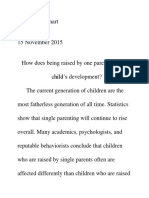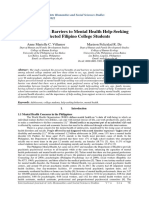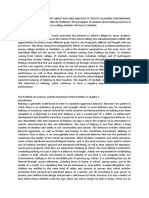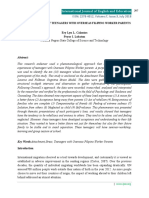0 ratings0% found this document useful (0 votes)
81 viewsRRL
RRL
Uploaded by
Do FernanThe document discusses how child development and behavior can be affected by parental relationships and broken homes. It notes that while a divorce alone may not cause issues, stress from parental separation or ongoing conflict between parents can negatively impact children's social skills development, mental health, and behavior. Younger children and adolescents are generally more vulnerable to these effects than older children or adults. However, keeping parents together in a high-conflict home may also be harmful to a child's development, as ongoing fighting can damage children emotionally and cause them to mimic unhealthy behaviors. The degree of impact depends on factors like a child's age at the time of divorce or separation and the quality of their relationships with each parent.
Copyright:
© All Rights Reserved
Available Formats
Download as DOCX, PDF, TXT or read online from Scribd
RRL
RRL
Uploaded by
Do Fernan0 ratings0% found this document useful (0 votes)
81 views10 pagesThe document discusses how child development and behavior can be affected by parental relationships and broken homes. It notes that while a divorce alone may not cause issues, stress from parental separation or ongoing conflict between parents can negatively impact children's social skills development, mental health, and behavior. Younger children and adolescents are generally more vulnerable to these effects than older children or adults. However, keeping parents together in a high-conflict home may also be harmful to a child's development, as ongoing fighting can damage children emotionally and cause them to mimic unhealthy behaviors. The degree of impact depends on factors like a child's age at the time of divorce or separation and the quality of their relationships with each parent.
Original Description:
Original Title
rrl.docx
Copyright
© © All Rights Reserved
Available Formats
DOCX, PDF, TXT or read online from Scribd
Share this document
Did you find this document useful?
Is this content inappropriate?
The document discusses how child development and behavior can be affected by parental relationships and broken homes. It notes that while a divorce alone may not cause issues, stress from parental separation or ongoing conflict between parents can negatively impact children's social skills development, mental health, and behavior. Younger children and adolescents are generally more vulnerable to these effects than older children or adults. However, keeping parents together in a high-conflict home may also be harmful to a child's development, as ongoing fighting can damage children emotionally and cause them to mimic unhealthy behaviors. The degree of impact depends on factors like a child's age at the time of divorce or separation and the quality of their relationships with each parent.
Copyright:
© All Rights Reserved
Available Formats
Download as DOCX, PDF, TXT or read online from Scribd
Download as docx, pdf, or txt
0 ratings0% found this document useful (0 votes)
81 views10 pagesRRL
RRL
Uploaded by
Do FernanThe document discusses how child development and behavior can be affected by parental relationships and broken homes. It notes that while a divorce alone may not cause issues, stress from parental separation or ongoing conflict between parents can negatively impact children's social skills development, mental health, and behavior. Younger children and adolescents are generally more vulnerable to these effects than older children or adults. However, keeping parents together in a high-conflict home may also be harmful to a child's development, as ongoing fighting can damage children emotionally and cause them to mimic unhealthy behaviors. The degree of impact depends on factors like a child's age at the time of divorce or separation and the quality of their relationships with each parent.
Copyright:
© All Rights Reserved
Available Formats
Download as DOCX, PDF, TXT or read online from Scribd
Download as docx, pdf, or txt
You are on page 1of 10
Child development/ behavior can be affected by a number of things,
but a big factor may be the parents. Depending on the severity of a
broken home, the parent’s relationship with each other, as well as their
children, can affect how their children behave and may even develop.
This doesn’t mean that a parent’s divorce can make it so a child can
never climb steps or hop on one foot, but it can make it harder for
children to develop social skills and may even set back their
achievements. Depending on a child’s age, the separation of their
parents may cause extreme stress and, in the worst case, even
depression. However, keeping the parent’s married might not be in
the best interest either, depending on the family’s situation. In my
experience of coming from a broken home, I have never suffered from
developmental or behavioral problems. However, this may be due to
my parents living in the same house after the divorce, the age I was
when my parents got divorced, and also the relationship I had with
both of my parents, as well as the relationship they had with each
other. Parents have an impact on their children, married or not.
However, on average, broken homes have a significant impact on
children and may even continue throughout their life.
To understand how a broken home affects child development/
behavior, it is important to understand how children should normally
develop/ behave. Although a child may behave and develop at their
own rate, there are guidelines for a child’s development, as well as
behavior, when it comes to their mental ability. The image above
shows the developmental skills that a child should have at the given
ages, many of which have to do with motor and social skills. As seen in
the diagram, children need to develop things they can do to help
them do simple tasks, like brushing their teeth and walking heel to
toe. Developing motor skills will make a child become more
independent, seeing how they will be moving and grasping things on
their own. So this is a no-brainer: children need to develop motor
skills. But another thing a child needs to develop, also shown by the
chart, is social skills. This would include naming things and
understanding words. Barbara Solomon, a social worker with a
Bachelor of science degree in psychology and a Ph.D. from the
University of Southern California, comments how “a lack of social
abilities could signal a medical or developmental problem” (Solomon,
2004). So not only are a lack of motor skills an issue at a young age
but so are social skills. Lastly, there are three types of behavior that
parents should understand when it comes to their children. First, there
is a behavior that is approved. This includes behavior such as being
kind to other people, being understanding, and listening to others.
The second type of behavior is one that is not necessarily wanted at all
times but is tolerated. This behavior can be caused by the child being
stressed or sick and is understood in context, and, depending on the
family, different types of behavior are tolerated. The last type of
behavior is one that should not be tolerated. This type can be
troublesome for a child’s intellectual development and may even
cause harm to the “physical, emotional, or social well-being of the
child” (Normal Child Behavior, 2015). This type of behavior can also be
caused by the parent, depending on how they act emotionally.
Children may start to copy their parent’s behavior because of how
closely they follow them for the normal emotional reactions of society.
This may get troublesome, depending if the parent is aggressive and
acting upon anger. In this case, when a child starts to mimic their
parent, they develop the third type of behavior.
(I couldn’t copy the image because it is in a pdf and screen shots are
not working at the moment, so if you’d like to see the image click
here. It is the only image in the pdf.)
A study to show cognitive testing in teenagers is shown in the image
above. This study was done by Anna Sanz-de-Galdeano and Daniela
Vuri along with IZA, The Institute for the Study of Labor, in 2004. This
was a study to see if the cognitive development of adolescents were
changed based on the fact of their current family situation. This data
shows the families that are intact has a higher cognitive ability than
families that are not intact. However, the research that was also
conducted showed the same children having lower cognitive ability
before their parents got divorce. The research in this study shows that
teenager’s cognitive ability will not necessarily decrease, but that does
not say anything about the effect on younger children. This study
concludes that in the short run, adolescents with divorced families may
have a lower cognitive ability, even if they have a lower cognitive
ability before their parents are divorced. In the long run, this is the
same. This study is consistent with was Cherlin et al. (1995) said, as far
as the timing of a parental divorce, the age that divorce occurs “(ages
7 to 11 versus ages 11 to 16) in a child’s life does not make a
difference for young adult outcomes” (Sanz-de-Galdeano and Vuri,
2004). So whether a child is younger versus older when their parents
divorce, that does not necessarily mean it will affect them as an adult:
the child will have the same cognitive ability before divorce, as shown
in this study, as well as after the divorce.
Another study suggests that a parent has a big outcome on their
child’s emotional development. Being physically present may not be
enough for a child, and all that matters is their parent’s emotional
attachment to them (Volling cited in Moges and Weber, 2014). If the
parent is not emotionally connected to their child, “the child will
struggle to learn how to regulate his emotions and interact with others
appropriately” (Moges and Weber, 2014). With my personal
experience with divorce, my mother was physically there, but she was
never emotionally there. I would say that I suffered from irregular
emotions when it came to my mother. Sometimes, I would be really
happy with her because she was there with me. Other times, and
perhaps most of the time, I was angry with her because of how little
she seemed to care about my life. Because I was so negative towards
my mother’s negative attitude, it shows that this can “often [lead] to
even more behavioral problems” (Moges and Weber, 2014). This is
problematic when raising a child to become a well-adjusted adult
because it may lead to further complications when interacting with
others normally. There is no one way to raise a perfectly well-adjusted
child, but parents can take a few precautions when taking care of them
emotionally. It is important to give them “supportive environment,
positive feedback, role models of healthy behavior and interactions,
and someone to talk to about their emotional reactions to their
experiences” (Morges and Weber, 2014). This will assure that the child
will be alright emotionally when growing up, and not having any
problems when it comes to regulating emotions and interacting with
others.
A study in 1971 showed 60 divorced families along with 131 children.
After five years, two-thirds of the children “were clinically depressed,
were doing poorly in school, had difficulty maintaining friendships,
[and] experienced chronic problems such as sleep disturbances”
(Amato, 2005). As supported by the study, these children may have
started acting aggressive and “engaging in bullying behavior, both of
which can negatively affect peer relationships” (Green). However,
another study, done in 1970, showed how after two years of their
parent’s divorce, preschoolers did not show emotional and behavioral
problems like they did the year before. So why does one group of
children show more severe symptoms than the other group? The
answer is this: research shows that the second most vulnerable group
to divorce is young teenagers, represented by the group of children in
the study done in 1971 (Blakeslee and Wallerstein, 2006). The first
group to be the most affected by divorce are young children before
they enter school. So, in this case, preschoolers will not be as affected
as much as young adolescents would. At this age, young adolescents
are being nudged slightly into the world, thinking about future jobs,
school, sports and clubs, romantic relationships, and the list goes on.
With all of this, divorce might add to the list to make it more stressful
for the child resulting in emotional and behavioral issues. However, if a
parent did not want a divorce because of this reason, the outcome
might not be as well aspected as one might think. If a child’s parents
are always fighting, this will add more stress to the family and also
may emotionally damage a child. As stated previously, parents have
some say in how a child is emotionally. A child will also see how their
parents interact and their imitate behavior, as well as negative energy
(Moges and Weber, 2014). Fighting parents that stay together because
of their child may end up doing more harm than none. Broken homes
may not harm a child developmentally or cognitively but instead may
have an important role within their education, behavior, social skills,
and emotional skills depending on their age.
Compared to a child being from a divorced family, a child that is born
outside of marriage or only has one parent may “reach adulthood with
less education, earn less income, … are more likely to have a
nonmarital birth, … and report more symptoms of depression” than a
divorced child would (Amato, 2005). The single parent is also at a loss
financially, making it harder to buy their child things for school they
will need to succeed. When it comes to education, children with
broken homes may experience a lack of academic progress. This may
“stem from a number of factors, including instability in the home
environment, inadequate financial resources and inconsistent routines”
(Green). Education is generally linked with the type of job a person
receives, which in turn predicts their income. A survey done on
average income based on the level of education in 1996 showed a
high school graduate having $7,143 more annually than a high school
dropout. Continuing, someone with a bachelor’s degree shows to have
$23,101 more annually than a high school dropout, and an advanced
degree shows $46,306 more (Fagan, 1999). The story is the same with
divorced parents: earning annually $29,500 less than a married family
would, says a study was done in 1995 (Fagan, 1999). A child with only
one parent is two times more likely to drop out of school, making it
more difficult for them to earn a higher annual income than someone
who had graduated high school. Research shows “that children do
better at school and exhibit fewer behavioral problems when
nonresident fathers pay child support”(King cited in Amato, 2005).
With more money coming into the household, children are more likely
to receive things that will help them in school as well as outside of
school, building their academic progress, and making them stay in
school.
I conducted a survey asking teens the marital status of parents and
also behavior they have shown previously in their life. Although I only
got thirteen responses, they were responses I was not intending to
get. Out of the eight people who said their parents were married, five
of them said they have suffered from aggressive and depressive
behavior. Out of the four people who said they had divorced parents,
none of them suffered from aggressive/ depressive behavior. It’s
already been confirmed with research that, on average, children will be
better off growing up in a home where there are two biological
parents that maintain a safe environment for their children. As far as
depression goes, depression can be triggered by a lot of things
including grief, stress, major life changes, and even side effects of
medication (Tandoc, 2016). Depression and aggressive behavior
cannot always be directly connected to a child’s parent’s relationship,
but on average it has a big impact on the child’s life. However, if a
child is experiencing this type of behavior and it is directly linked to
the married parents, it may be because of fighting. E. Mark Cummings,
a psychologist at the University of Notre Dame, explains how “[k]ids
pay close attention to their parents’ emotions for information about
how safe they are in the family” (Cummings cited in Divecha, 2014).
Children go home for a place to feel safe, not attacked. Understanding
how close children follow their parent’s emotions will make parents
think differently about what they are saying when around their
children. Cummings goes on to say “[w]hen parents are destructive,
the collateral damage to kids can last a lifetime” (Cummings cited in
Divecha, 2014). Parents have an impact on their children directly, but
also collaterally, meaning they do not know what ways their parents
have impacted them. When I was growing up, I remembered a fight
my parents had that I could not remember until something triggered
it. After remembering the memory, I realized why I feel the way I do
towards aggressive behavior. This has impacted me, and most likely
will throughout my life, because of a fight my parents had when I was
younger. This continues to show the effect that parents have on their
children, even if they are still married. But in the end, several studies
still show children who have divorced parents may experience
struggles such as these and many others that will hinder their life in
the future.
It is hard to pinpoint what makes a child behave a certain way, or do
things the way that they do. But it has been shown over and over
through research that broken homes affect children, depending on
their age emotional standpoint with their parents, more than married
families do. There is never one way that a child can be raised, and just
because one may be brought up in a broken home does not mean
they will suffer from depression or emotional problems. Broken homes
will not necessarily hinder a child’s development or cognitive ability,
however, it may cause a problem with their education or behavior. On
average, a single parent or divorced parents earn less money than a
married family does, making it harder to pursue things that their
children might need for education or other needs, causing further
problems in the future. It is important for families to understand how
to provide a stable and safe home for children to grow up in to limit
problems, such as these. In the long run, a child that grows up in a
safe environment will grow into a well-adjusted adult and will pay off
in the generations to come.
Works Cited
Amato, P. (2005). – The Future of Children -. Retrieved December 8,
2016, from
http://futureofchildren.org/publications/journals/article/index.xml?jour
nalid=37&articleid=107§ionid=692
Divecha, D. (2014). What Happens to Children When Parents Fight.
Retrieved December 15, 2016, from
http://www.developmentalscience.com/blog/2014/04/30/what-
happens-to-children-when-parents-fight
Green, A. The Effect of a Broken Family on Development. Retrieved
December 2, 2016, from http://oureverydaylife.com/effect-broken-
family-development-5183.html
Fagan, P. (1999). How Broken Families Rob Children of Their Chances
for Future Prosperity. Retrieved December 12, 2016, from
http://www.heritage.org/research/reports/1999/06/broken-families-
rob-children-of-their-chances-for-future-prosperity
Fowler, K. How Does Divorce Affect Girls and Boys Differently? | Your
Divorce Questions. Retrieved December 5, 2016, from
http://yourdivorcequestions.org/how-does-divorce-affect-girls-and-
boys-differently/
Moges, B., & Weber, K. (2014). Parental Influence on the Emotional
Development of Children | Developmental Psychology at Vanderbilt.
Retrieved December 12, 2016, from
https://my.vanderbilt.edu/developmentalpsychologyblog/2014/05/par
ental-influence-on-the-emotional-development-of-children/
Normal Child Behavior (2015, November 21). 4, 2016, from
https://www.healthychildren.org/English/family-life/family-
dynamics/communication-discipline/Pages/Normal-Child-
Behavior.aspx
Sanz de Galdeano, A., & Vuri, D. (2004). Does Parental Divorce Affect
Adolescents’ Cognitive Development? Evidence from Longitudinal
Data. Retrieved from http://ftp.iza.org/dp1206.pdf
Solomon, B. (2004). Why Isn’t My Child Reaching His Milestones?
Retrieved December 12, 2016, from
http://www.parents.com/baby/development/problems/why-isnt-my-
child-reaching-his-milestones/
Tandoc, D. (2016) Lecture on
Depression Personal
Collection of D. Tandoc, Okemos High School, Okemos MI
Wallerstein, J., & Blakeslee, S. (2006). What Is the Best Time to Divorce?
Retrieved December 12, 2016, from
http://www.divorcemag.com/articles/what-is-the-best-time-to-divorce
Welton, R. (2016). The Effect of Divorce on Early Childhood
Development. Retrieved December 8, 2016, from
http://oureverydaylife.com/effect-divorce-early-childhood-
development-13072.html
You might also like
- Effects of Social and Emotional Learning On Student WellDocument1 pageEffects of Social and Emotional Learning On Student Welljay.alejo99No ratings yet
- 1st Summative Test in Org'n & Mgt. 2019-2020Document4 pages1st Summative Test in Org'n & Mgt. 2019-2020Do Fernan90% (10)
- Research Namin To Perception-Of-Students-Raised-By-SingleDocument11 pagesResearch Namin To Perception-Of-Students-Raised-By-SingleHenry De los ReyesNo ratings yet
- A Defense of The Jury SystemDocument2 pagesA Defense of The Jury SystemedepaloNo ratings yet
- Cross-Class Friendship and Academic AchievementDocument14 pagesCross-Class Friendship and Academic Achievementapi-534672471No ratings yet
- The Effects of Poverty On Child DevelopmentDocument6 pagesThe Effects of Poverty On Child DevelopmentIjeoma100% (1)
- St. Martin de Porres Catholic School: March 01, 2020Document8 pagesSt. Martin de Porres Catholic School: March 01, 2020Julies SamsonNo ratings yet
- The Negative Impact of Parental Separation in Academic Performance of The StudenDocument8 pagesThe Negative Impact of Parental Separation in Academic Performance of The StudenJohanie Bolawan MamaNo ratings yet
- The Effects of Single Parenting Style To A Child'S Academic PerformanceDocument42 pagesThe Effects of Single Parenting Style To A Child'S Academic PerformanceJessica ColladoNo ratings yet
- Broken Family ThesisDocument9 pagesBroken Family ThesisMa Angelica TugonNo ratings yet
- FINALs DEFENSE REVISE - CHAPTER-1-1-1Document84 pagesFINALs DEFENSE REVISE - CHAPTER-1-1-1Aaron Joshua GayaNo ratings yet
- University of Central Punjab: "Quality in Education"Document21 pagesUniversity of Central Punjab: "Quality in Education"Fahad Khan LangahNo ratings yet
- Background of The Study: St. Alexius CollegeDocument44 pagesBackground of The Study: St. Alexius CollegeArien Kaye VallarNo ratings yet
- Fowler Thesis 2015Document76 pagesFowler Thesis 2015Isaiah Samuel De GraciaNo ratings yet
- Effect of Broken Family To Students PerfDocument8 pagesEffect of Broken Family To Students PerfAl Cagas Jr.No ratings yet
- Group 4 ResearchDocument7 pagesGroup 4 ResearchVal ZacariasNo ratings yet
- Chapter 123Document13 pagesChapter 123Jayvee RamosNo ratings yet
- Background of The StudyDocument12 pagesBackground of The StudyAdin Ram FerrerNo ratings yet
- Sample Literature ReviewDocument12 pagesSample Literature Reviewapi-19284393075% (4)
- The Menace of Bullying The Academic Performance of Victims, Perpetrators in Nigeria SchoolsDocument29 pagesThe Menace of Bullying The Academic Performance of Victims, Perpetrators in Nigeria SchoolsFalade Solomon AdeyemiNo ratings yet
- Group 3 Final ResearchDocument48 pagesGroup 3 Final ResearchIvan NievesNo ratings yet
- The Lived Experiences Student With Broken Families: A PhenomenologyDocument2 pagesThe Lived Experiences Student With Broken Families: A PhenomenologyJellian CastorNo ratings yet
- Aftermath of Parental Separation in Children's Mental Health and Its Implication To Their Academic BehaviorDocument8 pagesAftermath of Parental Separation in Children's Mental Health and Its Implication To Their Academic BehaviorReenah Mei LuisNo ratings yet
- AaaaaaaaDocument29 pagesAaaaaaaaKhate Cassey ParalejasNo ratings yet
- Self EsteemDocument14 pagesSelf EsteemlorrainemalbaNo ratings yet
- Influence of BullyingDocument23 pagesInfluence of BullyingDanica FranciscoNo ratings yet
- Self-Esteem, Adjustment, Psychological Well-Being and AcademicDocument20 pagesSelf-Esteem, Adjustment, Psychological Well-Being and AcademicSt EfaniNo ratings yet
- Effects of Dysfunctional FamiliesDocument10 pagesEffects of Dysfunctional FamiliesemeraldNo ratings yet
- Tatay Nanay Stories of Solo Parents Final OutputDocument35 pagesTatay Nanay Stories of Solo Parents Final Outputroseanntripulca2004No ratings yet
- Parenting Styles of ParentsDocument13 pagesParenting Styles of ParentsArlene L PalasicoNo ratings yet
- Relationship Between Parenting Styles and Depression in AdolescentsDocument12 pagesRelationship Between Parenting Styles and Depression in AdolescentsSantosoNo ratings yet
- Practical Research 2 Effects of Broken Family On Social ConnectionDocument41 pagesPractical Research 2 Effects of Broken Family On Social Connectionjohnreycabulong0No ratings yet
- Cara ResearchDocument30 pagesCara ResearchMatt MoralesNo ratings yet
- Module 9-Child and AdolescentDocument64 pagesModule 9-Child and AdolescentRachelle malnawaNo ratings yet
- Chapter 1Document5 pagesChapter 1polianNo ratings yet
- The Impact of Parents Overseas Employment On Educ PDFDocument21 pagesThe Impact of Parents Overseas Employment On Educ PDFIcy AgapeNo ratings yet
- Familial, Educational and Economic Values and Experiences of Single Parents in CapizDocument212 pagesFamilial, Educational and Economic Values and Experiences of Single Parents in CapizOJ Oy100% (4)
- III GRP. 5 12 - A Research FinalDocument45 pagesIII GRP. 5 12 - A Research FinalJVNo ratings yet
- Audu Maryam ProjectDocument57 pagesAudu Maryam ProjectUGWUEKE CHINYERENo ratings yet
- Home Environmental Factors Affecting Students' Academic PerformancDocument9 pagesHome Environmental Factors Affecting Students' Academic Performancsimon0% (1)
- Delmundo 2019 - FinalDocument9 pagesDelmundo 2019 - FinalCall me PinguNo ratings yet
- Benefits of and Barriers To Mental Health Help-Seeking of Selected Filipino College StudentsDocument13 pagesBenefits of and Barriers To Mental Health Help-Seeking of Selected Filipino College StudentsIjahss JournalNo ratings yet
- Nature Vs Nurture NotesDocument6 pagesNature Vs Nurture NotesAnisa MughalNo ratings yet
- K-GSADS-A - Package Posible Prueba para Medir SOCIAL PHOBIADocument16 pagesK-GSADS-A - Package Posible Prueba para Medir SOCIAL PHOBIABetsyNo ratings yet
- ResearchDocument25 pagesResearchKimberly CrebelloNo ratings yet
- BULLYINGDocument26 pagesBULLYINGPol Raganit Jr.No ratings yet
- Fabores - Chapter 2Document15 pagesFabores - Chapter 2Maxenia FaboresNo ratings yet
- The Effect of Broken Home On The AcademiDocument31 pagesThe Effect of Broken Home On The AcademiMary AnntonethNo ratings yet
- The Impact of Low Self-Esteem On Overall Well-BeingDocument13 pagesThe Impact of Low Self-Esteem On Overall Well-Beingcastro816761No ratings yet
- Humss-Group-B-Practical-Research FinalDocument17 pagesHumss-Group-B-Practical-Research FinalEunice Alviar PalabricaNo ratings yet
- 7245 Social Rehabilitation and Reintegration Notes On Personality and Behavior DeviationDocument14 pages7245 Social Rehabilitation and Reintegration Notes On Personality and Behavior DeviationPriscilla Mumbi100% (1)
- Effect of BullyingDocument11 pagesEffect of BullyingAnonymous 2ch6hSNo ratings yet
- Cell Phone Addiction StudyDocument12 pagesCell Phone Addiction StudygeorgepanciuNo ratings yet
- Survey QuestionnaireDocument2 pagesSurvey QuestionnaireAngel IliganNo ratings yet
- Impact of Bullying On Academic PerformanDocument10 pagesImpact of Bullying On Academic PerformanVincent AbaygarNo ratings yet
- Abang Doris EnuDocument48 pagesAbang Doris Enujohn100% (1)
- HSC 421 Research PaperDocument13 pagesHSC 421 Research Paperapi-502687231No ratings yet
- Lived Experiences of Teenagers With OverDocument13 pagesLived Experiences of Teenagers With OvershahinaNo ratings yet
- Research 2Document53 pagesResearch 2sheila rose lumaygayNo ratings yet
- Effect of Parent's Gender On Academic Achievement of AdolosecentsDocument9 pagesEffect of Parent's Gender On Academic Achievement of Adolosecentslucylovesbooks6770No ratings yet
- The Effects of the Internet on Social Relationships: Therapeutic ConsiderationsFrom EverandThe Effects of the Internet on Social Relationships: Therapeutic ConsiderationsNo ratings yet
- Leadership - Orgn & Mgt.Document5 pagesLeadership - Orgn & Mgt.Do FernanNo ratings yet
- Latest BackIntelligence FWD Head ExercisesDocument7 pagesLatest BackIntelligence FWD Head ExercisesDo FernanNo ratings yet
- Org.&mgt - Appropriate Planningntechgniques & Tools13Document5 pagesOrg.&mgt - Appropriate Planningntechgniques & Tools13Do FernanNo ratings yet
- CHAPTER 1 AND 2 KRISTINE FINAL RepairedDocument56 pagesCHAPTER 1 AND 2 KRISTINE FINAL RepairedDo FernanNo ratings yet
- 2nd Summative Test - Org'n & Mgt. 2nd SemesterDocument4 pages2nd Summative Test - Org'n & Mgt. 2nd SemesterDo FernanNo ratings yet
- 2nd Summative Test - Org'n & Mgt. 2nd SemesterDocument4 pages2nd Summative Test - Org'n & Mgt. 2nd SemesterDo FernanNo ratings yet
- Daniel A. Bautista Grade Xii - Aristotle LnchsDocument2 pagesDaniel A. Bautista Grade Xii - Aristotle LnchsDo FernanNo ratings yet
- First Quarter Exam - Entrep 2019-2020Document7 pagesFirst Quarter Exam - Entrep 2019-2020Do FernanNo ratings yet
- Reflection Paper in Research ForumDocument2 pagesReflection Paper in Research ForumDo FernanNo ratings yet
- Daniel A. Bautista Grade Xii - Aristotle LnchsDocument2 pagesDaniel A. Bautista Grade Xii - Aristotle LnchsDo FernanNo ratings yet
- Data CollectionDocument1 pageData CollectionDo FernanNo ratings yet
- Thesis 1961D B8205s PDFDocument442 pagesThesis 1961D B8205s PDFDo FernanNo ratings yet
- Data CollectionDocument1 pageData CollectionDo FernanNo ratings yet
- Developing A Business Plan: Presentation To TPP November 2000 D.B. MatiasDocument12 pagesDeveloping A Business Plan: Presentation To TPP November 2000 D.B. MatiasDo FernanNo ratings yet








































































